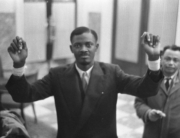Just show up. That sound and practical advice applies for actors who schlep from one discouraging audition to another or when you really don’t want to go near a gym. Off and on for about 98 years between them, artists Ushio and Noriko Shinohara have shown up, and this fly-on-the-canvas documentary departs from most behind-the-portfolio profiles by emphasizing the process rather than the re$ult, while offering a clear-eyed glimpse (for film) of how New Yorkers actually live—in cramped apartments that they can’t afford to vacate even if they wanted to.
This might be the only recent film set in New York City, feature or nonfiction, where paying the rent is a major concern; and the couple is one month behind. Talk about realism. And what they have is now hard to find: a two-level loft apartment with rooftop access in the Dumbo neighborhood of Brooklyn. They have lived there since the pre-gentrified ’80s.
Both are successful jobbing artists. Ushio has been prolific since the mid-1950s as a then-Tokyo-based pop artist, and his paintings and sculptures made from found objects still sell, though maybe not at the desired price. For more than five decades, he has created abstract-like works with a right-hook and an upper-cut to the canvas-as-a-punching bag, boxing with paint soaked gloves.
You’re not a philistine if you’ve never heard of either artist. There’s a tacit, and maybe unfair, suggestion that Ushio was once a contender. Back in the 1970s, he was profiled by both NBC News and by a Japanese television crew in a documentary with the portentous title The Last Artist, which followed him as an up-and-comer roaming grungy Soho streets finding discarded cardboard boxes to mold into sculptures.
For the camera, Ushio and Noriko willingly put their lives on display—it could be considered a performance piece. He preens, oozing testosterone, and pontificates; she’s much more reflective. He cast himself in the bad boy artist role, referring to his wife as “just an assistant” and “an average [artist] who has to support a genius.” She uses the camera as a confessor, and both make little attempt to make-nice for the audience. It’s like having dinner with friends and picking up on all of the undercurrents and finding out more than you bargained for.
Her autobiographical ink-washed drawings send up their relationship. Her cartoonlike creation, Cutie, is a pig-tailed cross between Betty Boop and a Vargas girl. Ushio’s alter-ego is Bullie, a pot-bellied Bacchanalian figure. Studying in New York, Noriko met Ushio at age 19; he was 41. Her Japanese parents were paying for her education abroad, and, perhaps unwittingly, Ushio’s rent. Now 80 and a recovering alcoholic, he has more energy than any coked-out character from a Bret Easton Ellis novel.
From last year, Marina Abramovic the Artist Is Present offers a more celebratory, glossy look of an artist’s life, one with a huge profile. That film covered her record-breaking exhibition at the Museum of Modern Art, a survey of her career, and her life in her all-white, airy Soho loft. In contrast, the Shinoharas have their hopes set on selling some of their works in their first shared gallery exhibition. At one point, Ushio travels back to Japan to sell some of his works, and he brings back $3600, all cash.
This documentary might also have to fight for the limelight, what with nonfiction films about troubled and deadly orcas (Blackfish), reenactments of atrocities (The Act of Killing), and the drone missile strikes in Yemen (Dirty War). This frank scenes-of-a-marriage is an anomaly. If its run in theaters is brief, it will likely find another home. This acidic, warts-and-all intimate portrait will play well on television.







Leave A Comment